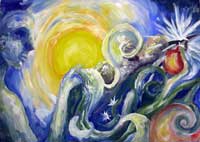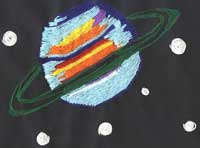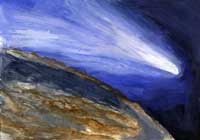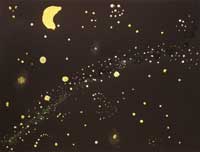School students Catch a Star! in an astronomical competition Inspire article
In Issue 3 of Science in School we invited you to join an international competition for school students and Catch a Star! Later, some of you helped to select winners by voting online for your favourite pictures. Douglas Pierce-Price from ESO reports on the results.

by Kristina, Lithuania (aged 15)
Catch a Star! is an international astronomy competition for school students, organised by ESO, the European Organisation for Astronomical Research in the Southern Hemisphere, together with the European Association for Astronomy Education (EAAE). In this year’s competition, students from 22 countries submitted hundreds of written projects and pieces of artwork on astronomical themes. Some of the winning pictures can be seen on the front cover of this issue of Science in School.

by Edyta, Poland (aged 13)
The standard of entries was most impressive, and made the jury’s task of choosing winners both enjoyable and difficult! We hope that everyone, whether or not they won a prize, had fun taking part, and learned some exciting things about our Universe.
The top prize, of a week-long trip to Chile, was won by students Jan Mestan and Jan Kotek from Gymnazium Pisek in the Czech Republic, together with their teacher Marek Tyle. Their report on ‘Research and Observation of the Solar Eclipse’ described how they had studied solar eclipses, and involved their fellow students in observations of an eclipse in 2006.
The team will travel to Chile and visit the ESO Very Large Telescope (VLT) – one of the world’s most powerful optical/infrared telescopes – where they will meet astronomers and be present during a night of observations on the 2600 m high Paranal mountaintop.

by Lazar, Russia (aged 12)
“It’s fantastic that we will see the VLT in action. I’m also looking forward to my first view of the southern sky!” said Jan Mestan. His fellow student is also excited about the trip. “I am very happy that we’ll visit the Paranal observatory, because this is one of the best astronomical observatories in the world, in the amazing scenery of the Atacama Desert,” said Jan Kotek.
This was a very well-written project, and we particularly liked the way in which the students involved the rest of their school. The team’s hard work was also helped by some good fortune, as it seemed at first that bad weather might block their view of the eclipse.

by Veronika, Czech Republic
(aged 12)
“It was cloudy, overcast, and a strong west wind was blowing in Pisek. The meteorological situation was nearly hopeless, and we thought we might have to cancel the observation. But luckily, the sky cleared up and we could see the eclipse!” said the students.
Other Catch a Star! participants won exciting trips to observatories across Europe. Emilio Rojas, Angel Sanchez, Javier Ortiz and their teacher Roberto Palmer from Spain won a trip to Koenigsleiten Observatory in Austria for their project ‘Jupiter on the Radio’. Bogumil Giertler, Ammar Ahmed, and their teacher Richard Burt from Italy won a trip to Wendelstein Observatory in Germany for their project ‘Determining the Relative Radiant of the Geminid Meteor Shower’. Victor Raimbault, Remi Takase, Thomas Salez and their teacher Michel Faye from France won a trip to Calar Alto Observatory in Spain, a prize kindly donated by the Spanish Council for Scientific Research, for their project ‘Light on Dark Matter’.

by Justyna, Poland (aged 16)
Forty other teams won prizes, which included astronomy software and sets of posters of stunning astronomical images taken with ESO telescopes. In the artwork competition, 60 winning pictures were chosen with the help of a public vote. The beautiful pictures created by students of all ages can be seen in the gallery on the Catch a Star! websitew1. The full list of winners is also available online.
The competition is over for this year, but why not encourage your students to Catch a Star! next year? Information will be available later this year on the competition websitew2.
Web References
- w1 – For further information about Catch a Star!, including a full list of winners and the art gallery, see: www.eso.org/catchastar/CAS2007/
- w2 – Information about the next Catch a Star! competition, and also about previous competitions, will be available here.
Resources
- Information about ESO’s other education initiatives is available here.





